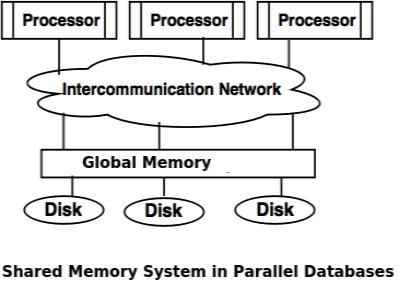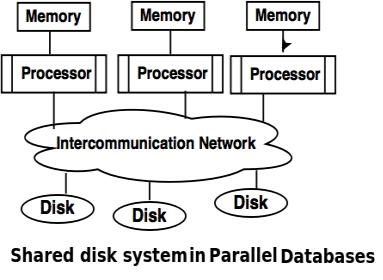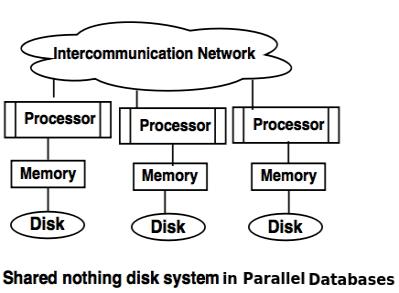Types of Parallel Database Architecture
Shared memory system
- Shared memory system uses multiple processors which is attached to a global shared memory via intercommunication channel or communication bus.
- Shared memory system have large amount of cache memory at each processors, so referencing of the shared memory is avoided.
- If a processor performs a write operation to memory location, the data should be updated or removed from that location.
 Advantages of Shared memory system
Advantages of Shared memory system- Data is easily accessible to any processor.
- One processor can send message to other efficiently.
Disadvantages of Shared memory system- Waiting time of processors is increased due to more number of processors.
- Bandwidth problem.
Shared Disk System
- Shared disk system uses multiple processors which are accessible to multiple disks via intercommunication channel and every processor has local memory.
- Each processor has its own memory so the data sharing is efficient.
- The system built around this system are called as clusters.
 Advantages of Shared Disk System
Advantages of Shared Disk System- Fault tolerance is achieved using shared disk system.
Fault tolerance: If a processor or its memory fails, the other processor can complete the task. This is called as fault tolerance.
Disadvantage of Shared Disk System- Shared disk system has limited scalability as large amount of data travels through the interconnection channel.
- If more processors are added the existing processors are slowed down.
Applications of Shared Disk System
Digital Equipment Corporation(DEC): DEC cluster running relational databases use the shared disk system and now owned by Oracle.
Shared nothing disk system
- Each processor in the shared nothing system has its own local memory and local disk.
- Processors can communicate with each other through intercommunication channel.
- Any processor can act as a server to serve the data which is stored on local disk.
 Advantages of Shared nothing disk system
Advantages of Shared nothing disk system- Number of processors and disk can be connected as per the requirement in share nothing disk system.
- Shared nothing disk system can support for many processor, which makes the system more scalable.
Disadvantages of Shared nothing disk system- Data partitioning is required in shared nothing disk system.
- Cost of communication for accessing local disk is much higher.
Applications of Shared nothing disk system- Tera data database machine.
- The Grace and Gamma research prototypes.
Hierarchical System or Non-Uniform Memory Architecture
- Hierarchical model system is a hybrid of shared memory system, shared disk system and shared nothing system.
- Hierarchical model is also known as Non-Uniform Memory Architecture (NUMA).
- In this system each group of processor has a local memory. But processors from other groups can access memory which is associated with the other group in coherent.
- NUMA uses local and remote memory(Memory from other group), hence it will take longer time to communicate with each other.
Advantages of NUMA- Improves the scalability of the system.
- Memory bottleneck(shortage of memory) problem is minimized in this architecture.
Disadvantages of NUMA
The cost of the architecture is higher compared to other architectures.


